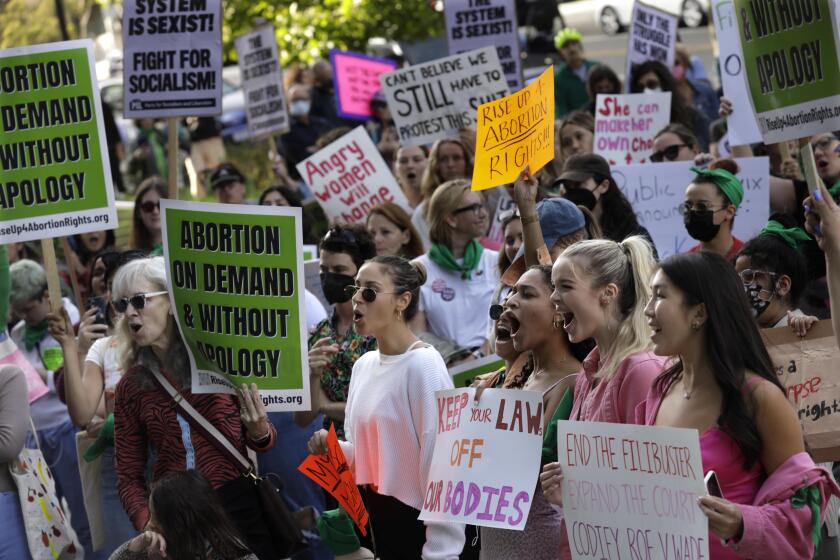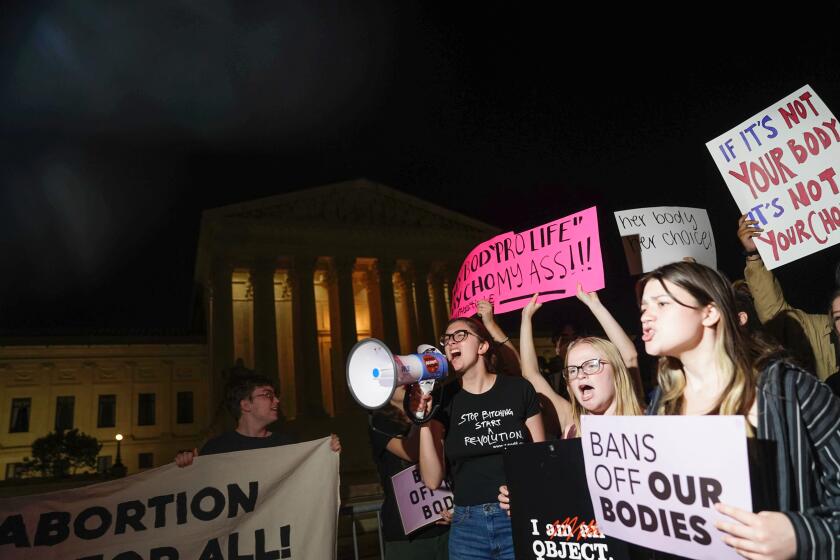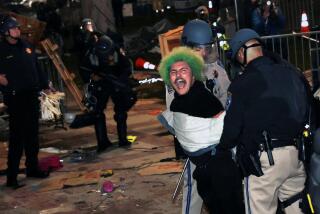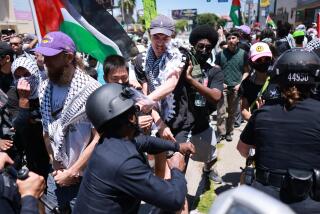Why did federal police square off with abortion rights protesters in L.A. streets?
- Share via
- Share via
An abortion rights protest had been going on peacefully for hours in downtown Los Angeles on Tuesday when a “help call” suddenly went out over police radios about 9 p.m.
The SOS didn’t come from Los Angeles police officers, but a small group of federal officers with the Department of Homeland Security. They claimed, according to a statement by the LAPD, that they had come “under attack” from protesters while in their patrol cars near the intersection of 5th and Hill streets — about a half-mile away from the federal courthouse where the protest had begun and where federal officers have jurisdiction.
Video showed protesters banging on the officers’ cars and taunting them in a circle, and the officers shoving protesters and screaming at them to “back up.”
Some witnesses have accused the officers on social media of instigating the confrontation by straying beyond the courthouse, driving into the crowd and using aggressive crowd control measures. Regardless, it ratcheted up tensions between law enforcement and protesters at what until then had been an orderly demonstration over a draft Supreme Court opinion that, if adopted, would undercut abortion rights nationwide.
The scene also raised questions as to why federal police officers were squaring off with street protesters in L.A. — especially so many blocks from the courthouse.
“I am confused as to why federal agents were out in Los Angeles doing crowd control during last night’s abortion rights protest?” activist and City Council candidate Albert Corado tweeted Wednesday, in response to a video of the encounter that has been viewed 3.5 million times.
About 400 people rallied in front of a federal courthouse before marching to Pershing Square, where police declared an unlawful assembly.
A spokesman for the Federal Protective Service, an arm of Homeland Security to which the federal officers are assigned, referred questions from The Times to the main DHS public affairs office. In a statement Thursday, that office said DHS “strives every day to protect Americans’ freedom of speech and other fundamental rights,” and that the FPS “is conducting a review of this incident and the actions of any DHS personnel involved.”
In its own statement, the LAPD said the department had not requested assistance from Federal Protective Service during the protests and that its officers had not been working in conjunction with the federal officers who called for help.
The incident is the latest in recent years in which federal agents have stepped into and seemingly exacerbated tensions at protests in U.S. cities, where their role and legitimacy in enforcing laws are on shaky legal ground, according to legal scholars.
Activists and city officials have called out the presence of federal authorities at protests in Portland, Ore., Seattle and Washington, D.C. In one altercation that drew fierce condemnation from elected officials and others, federal agents used forceful measures to clear racial justice protesters and members of the media from Lafayette Park near the White House in 2020, as then-President Trump was staging a heavily criticized photo shoot at a nearby church.
A draft opinion circulated among Supreme Court justices suggests that earlier this year a majority of them had thrown support behind overturning the 1973 case Roe v. Wade that legalized abortion nationwide, according to a report in Politico.
Legal experts said Tuesday’s incident raised serious questions.
“What was the justification? What was the need for federal law enforcement officers to be deployed in that instance, where there appeared to be no threat to the federal courthouse?” said Jimmy Gurulé, a University of Notre Dame law professor and former undersecretary of enforcement at the U.S. Department of the Treasury, where he oversaw various federal law enforcement agencies.
“It’s a very fundamental and reasonable question, and if they can’t answer that question, then that raises some serious questions as to whether they were there to maintain the peace or to instigate.”
For part of Tuesday, federal officers were protecting the federal courthouse in the 300 block of W. First Street downtown, where protesters had gathered to denounce the draft Supreme Court opinion.
About 7:30 p.m., protesters moved from the courthouse toward Pershing Square — a shift LAPD officials said they discussed in advance with organizers of the protest and helped to facilitate by blocking traffic. Speeches were given in both locations.
Organizers declared the march over about 8:30 p.m., and the crowd began dispersing. Up until that point, there had been “no incidents of note,” the LAPD said.
The FPS officers were at the intersection of 5th and Hill streets by 8:40 p.m., when dozens of protesters were departing the park and spilling into the street. Some began banging on the hoods and trunks of the FPS officers’ cars.
Videos of the scene posted to social media, as well as statements from the LAPD and witnesses, show that LAPD officers took a more forceful stance after the FPS officers squared off with protesters. That, in turn, quickly escalated tensions further as protesters jeered at and taunted the officers and the officers screamed back, pushed people and hit them with their batons.
Videos posted online by Vishal Singh, who regularly chronicles protests in L.A., and other activists showed an FPS officer driving through a crowd of protesters into the intersection with the car’s sirens blaring. Another FPS officer then stepped out of a second patrol car in the intersection with his baton drawn.
“Back up,” the FPS officer said to protesters, a few dozen of whom can be seen in the video. The officer can then be seen shoving a protester backward after the person spoke to him.
“Back off,” the officer said. “Don’t do that, you understand me?”
More protesters moved forward at that point, yelling at the officer to back up.
Another video showed a different FPS officer moving through the same crowd, shoving people along the way to reach the side of the first officer and a few others, who had retreated a short distance toward a Metro bus in the street.
LAPD officers soon arrived in large numbers and a LAPD commander at the scene quickly declared the gathering unlawful. People were ordered to disperse and LAPD officers formed skirmish lines and began pushing through protesters to clear the street.
Amid the commotion, LAPD officers attempted to make at least one arrest. A video showed an officer chase and tackle one masked protester to the ground, but other protesters intervened, scuffling with officers as one swung at them with his baton.
Asked about that specific incident, video of which was posted to Twitter, LAPD officials said the officers “were attempting to effect the arrest of a vandalism suspect when people within the crowd attacked the officers and facilitated the suspect’s escape.”
They said the department has since launched a “use of force investigation related to the officer’s actions” in the incident and, therefore, could not comment on it further.
The LAPD did not respond to questions about other videos showing officers knocking over a protester’s wagon with a speaker in it, and officers pushing protesters in the street.
The situation quickly died down as protesters dispersed. A smaller crowd later roamed around downtown for a bit, causing minor damage to City Hall. The LAPD said it made no arrests.
After massive protests spiraled out of control in L.A. following George Floyd’s murder by Minneapolis police in 2020, multiple reviews found shortcomings in how the LAPD had responded. Top LAPD officials later expressed regret, saying they had learned lessons about how to better handle protests and would in some instances diminish their presence in part to avoid unnecessary clashes.
For much of Tuesday’s abortion rights protest, the LAPD had maintained a peripheral presence.
In response to questions about the presence of the federal officers Tuesday night, LAPD Chief Michel Moore said the agency is “working with our partners to ensure clear coordination” moving forward.
Los Angeles Times reporter Andrew J. Campa contributed to this report.
More to Read
Sign up for Essential California
The most important California stories and recommendations in your inbox every morning.
You may occasionally receive promotional content from the Los Angeles Times.














